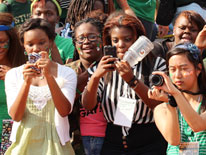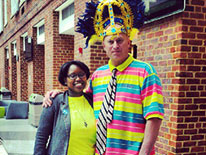
Five. That’s how many languages into which the mission statement is translated on the Woodrow Wilson High School website. It’s the first sign of an extraordinary school that boasts, in the words of the principal, “extreme diversity”. It’s also a school where scholars (that’s what they call students) can spend 24 hours straight creating art, where teachers instruct teens from dozens of countries and every walk of life, and where 27 Advanced Placement courses are offered to Wilson Tigers....
Here’s more from a conversation with Principal Peter Cahall and Director of Academic Development, Alex Wilson.
On being a beacon of diversity:
Principal Cahall: We value our extreme diversity. And it’s a community feel. We do eight open houses. Wilson is a total community facility, there are activities 6-7 days here a week. It’s a center belonging to a community, so it’s very active.
Mr. Wilson: We embrace scholars from 80 countries, blind, deaf, refugees, families in exile, scholars from multimillion dollar homes, and a good deal that come from economically disadvantaged homes. The scholars are accepting of anyone gay, straight, short, tall-- it really is amazing to me, how open and welcoming it is.
On what makes his heart sing:
Principal Cahall: I love being around my scholars and my staff. Over spring and summer break, it just feels like the longest time because I like interacting with the people I work with and the scholars I work for. One day is never the same as the next or the other; there are always surprises. But the fact that I know that we’re changing lives and allowing others to experience or even consider their dreams… that just makes my heart sing. It gives me joy.
On the teachers at Wilson High:
Principal Cahall: A lot of teachers go above and beyond in supporting our scholars. Teachers like Belle Belew—she runs an event called the 24-hour HAM (Humanities, Arts, Mass Media), in which some scholars stay at Wilson and do all these activities-- they write skits and read poetry. They prepare a performance for their parents that evening, featuring drama, dance, spoken word, poetry, fine art. Then they do a “Night Write”—where they walk around the school and do some writing. Then they walk a half-mile to a teacher’s house, have a campfire, come back to school and we show movies in the theater. Our SciMaTech Academy (science, math, and technology departments) is doing something similar on Pi Day (3/14). Spending 24 hours with teens—many might not see that as fun but our teachers do it voluntarily.
Another teacher is Harriet Bronstein; she’s a part-time drama instructor and she works miracles with musicals and the plays are out of this world. The hours she spends and rehearsing it with the scholars… it brings tears to my eyes when I see the production.
There’s Angela Benjamin, our science and engineering teacher who also runs the robotics team. She is no-nonsense but she has a love for scholars, and they blossom into young adults. She has such a passion and compassion for serving them.
What makes Wilson scholars unique:
Principal Cahall: This is my 4th school district. Wilson scholars are more worldly, savvy, and mature than any other students I’ve encountered. They’re little adults. They’ve learned how to self-advocate and be independent, and the creativity and the skill that they bring just amaze me.
On improving Wilson:
Principal Cahall: When I first got here five and half years ago, scholars and adults were angry. Now, I feel like they are in a calm, safe and secure environment where we see all scholars of all races and levels increasing their achievement levels. We have more scholars earning honor roll than they did 5 years ago. On average, we had 33 percent on honor roll in 2009 and last year, 42 percent. We’ve increased the number of scholars taking AP courses. When I came, there were 313 scholars taking AP tests, and last year we had 775 scholars taking them.
I “adopted” 26 scholars who last year were well below 2.0 or even 1.0. I call them the Cahall scholars, because I meet with them weekly, and I pull up their grades and ask them what they need, and what problems they’re having. I’m checking their attendance, too. And I’ve seen an average of a 1.0 increase in their GPA from last year to the first advisory—end of October 2013.
My job is about relationships and communication. We spend a lot of time getting to know scholars, what they are like, what their interests are. We send home a weekly note to parents, scholars, and staff. It’s a 2-3 page letter about things that went well, things that are coming up. We have an assembly the first day of school, when we talk about goals and expectations, and having everyone understand the plan to meet them.
On AP classes and closing disparities:
Principal Cahall: When I first got here, I would look into classrooms and I knew which ones were all-level and which were honors and AP. I know this because the honors and AP classes were white and Asian and the all-level classes were Latino and black. Then I studied the PSAT for ability or potential. I looked at the scores in the honors and AP classes compared to the all-level. And what I discovered was that I had scholars who could sit in the honors and AP classes but were sitting in the all-level. The counselors were asking the scholars, “Why are you in the all-level when you could be in the honors?” And the scholars answered, “Because I don’t have other scholars that look like me in those classes.” So I knew that we needed to invite, encourage, and provide support for scholars in those classes. Like I said before, we had 311 scholars taking AP tests when I came, and last year we had 602 scholars taking them.
I believe all children are smart and can learn. I’m the first person in my family to go to college. My parents didn’t graduate from high school. I’m doing what my teachers, coaches, and administrators did for me. They showed me I could be successful and get a college and masters degree. And I’m giving back what I was given when I was young.




